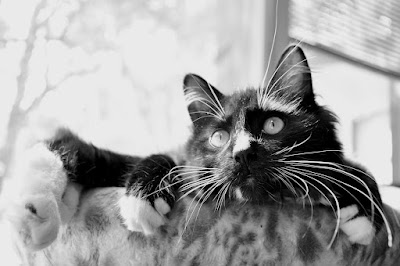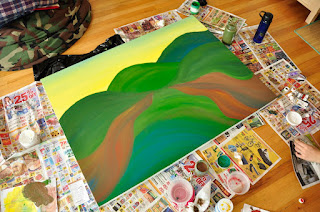
imaged: visible impression obtained by the refraction of a lens, or the passage of luminous rays through an aperture -Intellection: a conception or idea as the result of notion or thought
31.12.09
7.12.09
Interview with Greg Gerla

Greg Gerla is a commercial Photographer and Teacher in Calgary Alberta, the following are his thoughts and words of wisdom:
Q: You are a Commercial Photographer in Calgary, can you tell us how that came about?
A: I came to ACAD in 86, not really anticipating that it would be a career. It wasn’t until my final year that I realized I could probably make some money at it. So, after graduation I assisted and the struck out on my own. The rest is history.
Q: How is the Market in Calgary for commercial work?
A: If you are a good shooter the market is good. My philosophy is that if you’ve got a good product, there will be business for you. So I’ve never really pulled my hair out wondering if there are enough jobs out there. I know that if I’m a good shooter and if I provide clients with good products there will be jobs out there for me to shoot.
Q: Tell us about your journey getting to this level of success as a commercial photographer
A: A lot of ulcer medication, ha ha ha, no it’s good because there are great aspects to having your own business, having your own photo business. But it’s tough; the market now days is a bit tougher so you have to really have a passion for it. That’s what gets you through the tough times. That’s what keeps you waking up the next morning and going to the studio, even though you haven’t had a job in the last three weeks, maybe there will be one today. You have to have the passion for it, it’s a lot of bloody hard work, but it’s a great job.
Q: What made you stay primarily in Calgary for your practice?
A: Quality of life. A lot of things that had nothing to do with photography, I like the city, I like the climate (most of the time), and I like the fact that it’s close to the mountains. The people here are nice, the air is clean, and it might not be the center of the photo universe but it really balances my life. As opposed to perhaps going to New York, which would be the center of the photo universe, but having visited New York I just find that I don’t think that I could live in that city.
Q: Would you say that your style has evolved/changed since you first started, and if is has how so?
A: It totally has in some ways and totally hasn’t in others. It’s like your personality, you know people I think as they get older they shift in terms of who they are, and a lot of that has to do with experiences that you’ve gone through, it adds to who you are. Do I shoot the same way that I did when I graduated? No. There are elements of similarity, but I think the work that I do now has just been added to. Every time I look through my camera I’m adding another layer to my experience and my craft. Hopefully that comes through in the shots that I do, and adds to the shot that I’m going to do tomorrow.
Q: Do you enjoy shooting without the pressure of doing it for a client? If so, what kind of personal work do you do?
A: Someone, I can’t remember who, said that the only trouble with commercial photography are the clients. God bless them because they pay for the studio and they put food in my cupboard, but you are hired sometimes for a job that is someone else’s vision. There are times when you have to put your insight and artistic creativity on the backbench, and just give them what they want. That’s why it’s important to do your own work, to exercise that aspect of your creativity. So I find that as much input that I can have on a commercial job, I’ll take it. When I don’t get that input, that’s when I’ll come into the studio on the weekend and do my own shots.
Q: Would you ever consider showing these works in a gallery setting, if you haven’t already?
A: Oh absolutely, sometimes they make their way into my portfolio that I show clients, but I have a fine art practice and I try to have at least one show a year where that work comes out.
Q: Where do you usually show it?
A: Last year I had a show at Axis Gallery, as well as here at the studio, we transformed our studio for two weeks into a gallery. We are going to be doing that again this spring. If there is opportunity for a group show, like every other year ACAD has a faculty show. I participate in that, so I like to hang whereever I’m invited to.
Q: You share a studio with two other people, do you guys ever collaborate?
A: Oh yeah it’s great. It’s such a benefit to have people to bounce ideas off of, and to get some good creative feedback on my work. We do actually collaborate a lot; we try to have work in our front lobby area that’s purely personal that we’ve shot together to have almost like a mini show. We each get one piece hung on the wall.
Q: What inspires you? Are there any photographers out there that influence your work?
A: Edward Steichen is my hero, in terms of the work he’s done and the things that he’s put together. I’m drawn to historical shooters, or any of the big names, Avedon, David Bailey, and Helman Newton. Painters also inspire me and other artists you have the ability to see things their own way or to capture light their own way. I try to take it all in and distill it.
Q: How would you describe the photography scene in Calgary?
A: Could be worse, could be better. The great thing about the art college is that there’s a constant influx of new blood, and that is healthy for the industry. I would like to see Calgary and the community in general paying a little more attention to photography. I wish there were more shows, I wish there were more exhibitions from big name shooters that came through, and I wish corporate companies were actively purchasing photography for their art collections in their offices and their hallways. But that said it’s better than it was and that’s a good sign, and hopefully it will continue to get better. Photography is getting a little more respected at least in terms of being considered an art form, where as two decades ago that wasn’t the case. If it keeps moving in that direction then that’s a good thing.
Q: What’s next? What’s in store for you and your practice in the future?
A: Well, onward and upward, my whole mandate ever since I became a pro was to try and do better this year than I did the year before. Whether that’s in terms if income or new equipment, or an additional exhibition, or just being gratified by my personal work. I’m always trying to push myself to get a little bit further, do a little bit more, and maybe learn a little bit more that I didn’t know last year. So that’s always the case, just pushing and hopefully always growing.
Q: What kind of tips do you have for the up and coming photographers in Calgary?
A: Passion is the main thing. Be passionate and care about what you do. Don’t be discouraged, you grow in adversity. If you find yourself blocked creatively or you haven’t had a job come through, that’s when you can really start to grow as an artist and a business person. Keep at it, keep working hard and don’t loose your passion.
Q: Any last words of wisdom?
A: Time flies, if you’re a student enjoy it. Carry your camera with you and use it to find inspiration.
You can find more info and some of Greg's Work here: http://www.greggerla.com/
Interview with Audrey Smith

A: RESULTS Canada in an NGO/lobby group that operates in five countries. The work that they do is to inform governments of worthwhile ways to commit funding to those that live in extreme poverty.
The kind of work they focus on are the conditions of poverty such as sanitation, water, education, and combating epidemics that are easy to fight with simple treatment like tuberculosis.
They focus the work anywhere in the world that people live on less that one dollar a day, like lots of countries in Africa. But there are lots of other places in the world where people live on less than a dollar a day.
Q: How long have you been actively participating with the organization and what sparked your interest to join?
A: I have been connected with it on one way or another for four years. A friend actually made me aware of it and it seemed like such a treat to be connected with people who are doing something about world problems in a direct and effective way
Q: You are an Art Teacher as well as a practicing artist. It must have seemed natural to establish Pottery to End Poverty to enhance fundraising opportunities for RESULTS Canada. Can you tell us what Pottery to End Poverty is, and what inspired you to bring art to RESULTS Canada?
A: A lot of the work of RESULTS is writing letters to politicians and that is really effective but, my work is to make art and to make art in community. It’s important to me to establish community and as I was working to prepare for a major fundraiser, I had the image of pottery on the tables with grain in the pots. It came out of a deep respect of the art forms of many of the countries we work with. Their art making is powerful, and it isn’t less than in any way, than the work we do. And so it felt like a natural collaboration to make pots and especially pots that honored the pottery making that happens in a lot of countries, and to do that in community. I think that we give because we need to give, not because they need us to give. I think that we need to make art for our health, and celebrating that art making in a communal effort is really exciting.
Q: Can you comment on the success of Pottery to End Poverty thus far?
A: Well I think It’s successful because it just keeps morffing into whatever form is appropriate for the year. We’ve done it for 3 years now and it’s different every year. I think to me if it stayed the same some people might call that success, but that isn’t for me. It has to fit into my life and it has to work in a way that fits into the lives of whomever wants to contribute. Different people have different time and different energy.
Q: Do you think Art is a strong tool to augment social and ethical change? If so, do you think that power is overlooked, or celebrated?
A: I think it’s a core, a very powerful tool for health, and I think it’s a powerful tool to express what needs to be said in ways that sometimes words can’t accomplish. I think that lots of people are doing that and I’m excited to see the incredible impact that artwork has had, and is having to change the world. But I think it is also really important that we make art for ourselves, and I think that is being overlooked. Our health is actually not that great in terms of our spiritual health, and I think our art making gets lost in our sophistication.
Q: In your personal practice as an Artist is it important to you that your work carries Ethical weight, for example does it comment on social conditions, or lend awareness to specific issues?
A: Sometimes. I think sometimes it’s important for me to submit to the art making and not require of it any pre-decided idea. It’s like Gloria Steinem once said, “Art making is political because it’s an expression of self, and that will end up being political.” I think that there are some artists like Chris Jordan that strive to make work that is intensely political and it’s wonderful. But that’s not always how i work. I guess one of the political aspects of my art making, in a way, is that its made in community a lot. And that is an important part of the art making, to do it in collaberation, working together and getting people together in community. So far I’ve made a lot in community so my art making and my teaching are mixed a lot more. In a way, that process has an affect that in some ways is political.
Q: Are artists of all mediums able to join and contribute with their work to Pottery to End Poverty, be it photography or Jewelry etc?
A: Absolutely, and that one of the most exciting things, watching people come in and contribute, and seeing how people respond to it.
Q: RESULTS Canada, and Pottery to End poverty are both organizations composed of a very strong sense of community, how can others who want to help get involved?
A: Anybody who would like to be part of it can connect with me, and they can be part of it by actually coming and making art in community. What has also worked well is for people to work in anyway that is comfortable for them, and then to come and bring their artwork in. Any work that shows up is welcome!
Anyone interested in RESULTS Canada can find more information at their website: http://www.results-resultats.ca/main/default-en.aspx





































